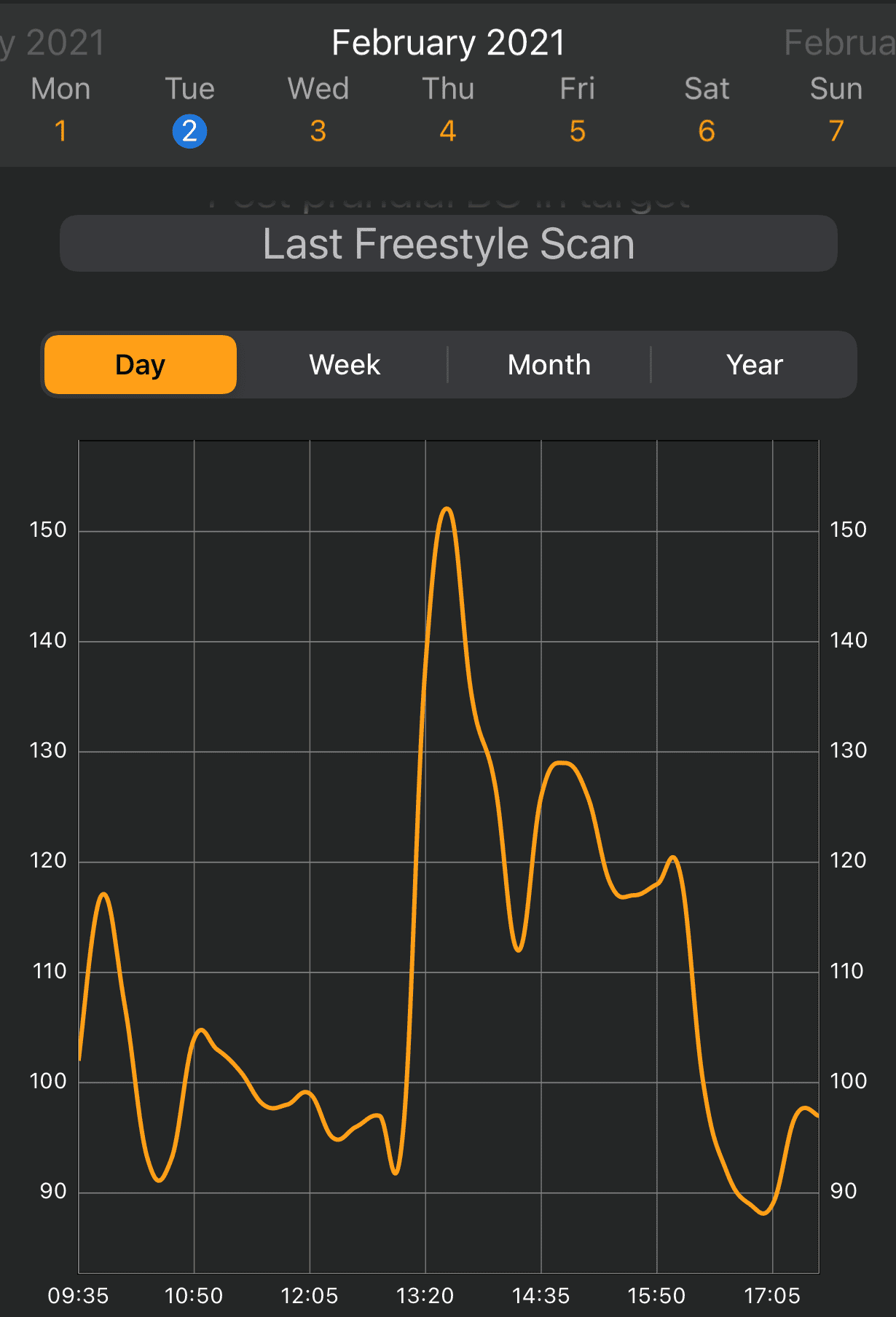Experimenting with a Continuous Glucose Monitor
For the past two weeks, I wore a continuous glucose monitor (CGM) on my chest. I'm not diabetic. I did it because I'm really curious. I want to know more about my health and how food affects me.

For the past two weeks, I wore a continuous glucose monitor (CGM) on my chest.

Why
I'm not diabetic. I did it because I'm really curious. I want to know more about my health and how food affects me.
I had heard of a program called Levels Health where they give you a CGM and thanks to the app, you can improve your Metabolic Score, keeping the glucose low and constant.
The app also rates the food you ate depending on the glucose spike it generates. For example, Coca-Cola rates 1/10, as you can imagine: it's pure sugar mixed in water. But maybe other foods are not so healthy as you think.
Justin Mares launched a nice social experiment involving Levels sensor, where you put money on the line (800$) and you get some of it back for each day your glucose stays below a certain threshold. Read more here.
Unfortunately, at this time of writing Levels Health is not available outside the US. So I had to come up with a DIY solution.
The sensor
Looking for an alternative, probably the most famous sensor is the Dexcom G6. But I was not able to purchase it, is not very consumer friendly, as you probably need a prescription from your doctor.
The sensor I got at the end is the Freestyle Libre 2. Easy to obtain via their website and it connects directly to the phone via NFC. It costs around 60$-70$ (I paid 65CHF).
This is not actually a continuous glucose monitor as it takes a sample every 10 minutes and records it for 8 hours. But is good enough to have an idea of how much sugar you have in the blood.
The official app FreeStyle LibreLink app is quite essential and doesn't give you any kind of statistics. And the measurement units are locked on mmol/L.
Luckily I found another one called Diabeto Log, much more complete. Take a look at the screenshot.

The big spike in the picture after 13:20 is a small lunch with instant noodles, it's quite high for a non-diabetic. And it takes a long time before coming down to a proper level of 90-100 mg/dl.
To give you some other examples:
- As soon as you wake up (you are in a fasting state), the level is around 90 mg/dl.
- A lunch with curry chicken (without rice) will barely reach 120 mg/dl as it's mostly protein.
- A snack with yogurt and cereals will go up to 140 mg/dl.
- If you are trying to lose weight, you should always try to be below 100 mg/dl.
What Jocko Willink thinks about sugar
Today I picked up again a book from my library called "Discipline equals Freedom" by Jocko Willink, an ex Navy SEAL.
In the chapter "Fuel: feeding the machine" he discusses how food affects your body- One of the few things we can control.
He's talking about glucose, and I could not explain it better. This is an extract:
There is another balance that our body maintains that we have a huge influence over. Is it our blood glucose level, what we normally call our blood sugar level. We can directly influence our blood sugar levels by what we eat.
When we eat carbohydrates, our blood sugar levels go up. When we eat carbohydrates, our blood sugar levels go up a lot.
The primary action our bodies take to regulate high blood sugar levels is to release the hormone insulin into our blood from the pancreas. Once released, insulin pushes the sugar in the blood into fat cells and also slows down the process of fat in the fat cells being pulled out and used for energy. Obviously, when your body is putting fat into fat cells and not using your fat for energy, you get fatter.
There are other extremely negative effects of continued elevated insulin levels in the blood beyond gaining or maintaining body fat.
Consistent spiking of insulin in the blood can lead to insulin resistance, which can eventually lead to type 2 diabetes. Other long-term impacts that prolong that pronged elevated insulin levels can cause are heart disease, diabetic retinopathy (blindness), strokes, and kidney failure. Not good.
So, the solution seems obvious: stop eating carbohydrates - or at least minimize carbohydrate intake.
Why is that so hard? The answer is simple: Carbohydrates are addictive. Yes, sugar is like a drug in your brain and causes neurochemical responses similar to drugs like heroin.
- Jocko Willink - Discipline Equals Freedom
The future
This experiment made me more conscious about what I eat. I'm going to reduce my carbohydrate intake and avoid sweet stuff (cookies, snacks, cereals).
In the future, I would be curious to repeat this experiment in a different condition. For example, while fasting for few days or doing keto.
The sensor space is alive
The Freestyle Libre 3 was recently announced and should arrive later this year. Improvements include a form factor that is 70% smaller and an always-on connection with the phone over Bluetooth Low Energy. Price stays the same.
I heard some rumors that the new Apple Watch Series 7 could come equipped with an optical blood glucose sensor. It seems like also Samsung is going to add a similar sensor on the Galaxy Watch 4.
It could make sense, since Apple has been adding a new sensor every year, on newer version of the Apple Watch.
Update: probably this will not happen this year,
If the sensor is accurate enough and gamification is going to be implemented software-wise, I feel like it has the potential to make millions of people more aware of what they eat. And subsequently, change the food market.
Rumors say that an optical glucose sensor is going to be on the next Apple Watch 7 and Galaxy Watch 4
— Lorenzo Cella (@LorenzCella) February 11, 2021
If the software & accuracy is good enough, having millions of people knowing how sugar in their food affect them is going to be a big thing
Could even change the food industry
Response
After sharing this experience on Twitter, I got two different types of response. People interested in technology, like me, that wants to know more about their metabolism, and people that were worried I'm stealing sensors from diabetic people that are in need.
From the first grounp of people, I got reccomended two companies with better sensors and apps. I would be excited to try them in future:
- Veri. "Find the better fuel for your body". Looks very similar to Levels Health but it's available in Europe. Targeting metabolic health and they are using Freestyle Libre, but with an app that looks very nice.
- Supersapiens. Powered by Abbot Libre Sense, a bluetooth continuoous glucose monitor. Targeted at real athlets that wants to know more about their energy during workouts. Starting a 150 euro a month.
